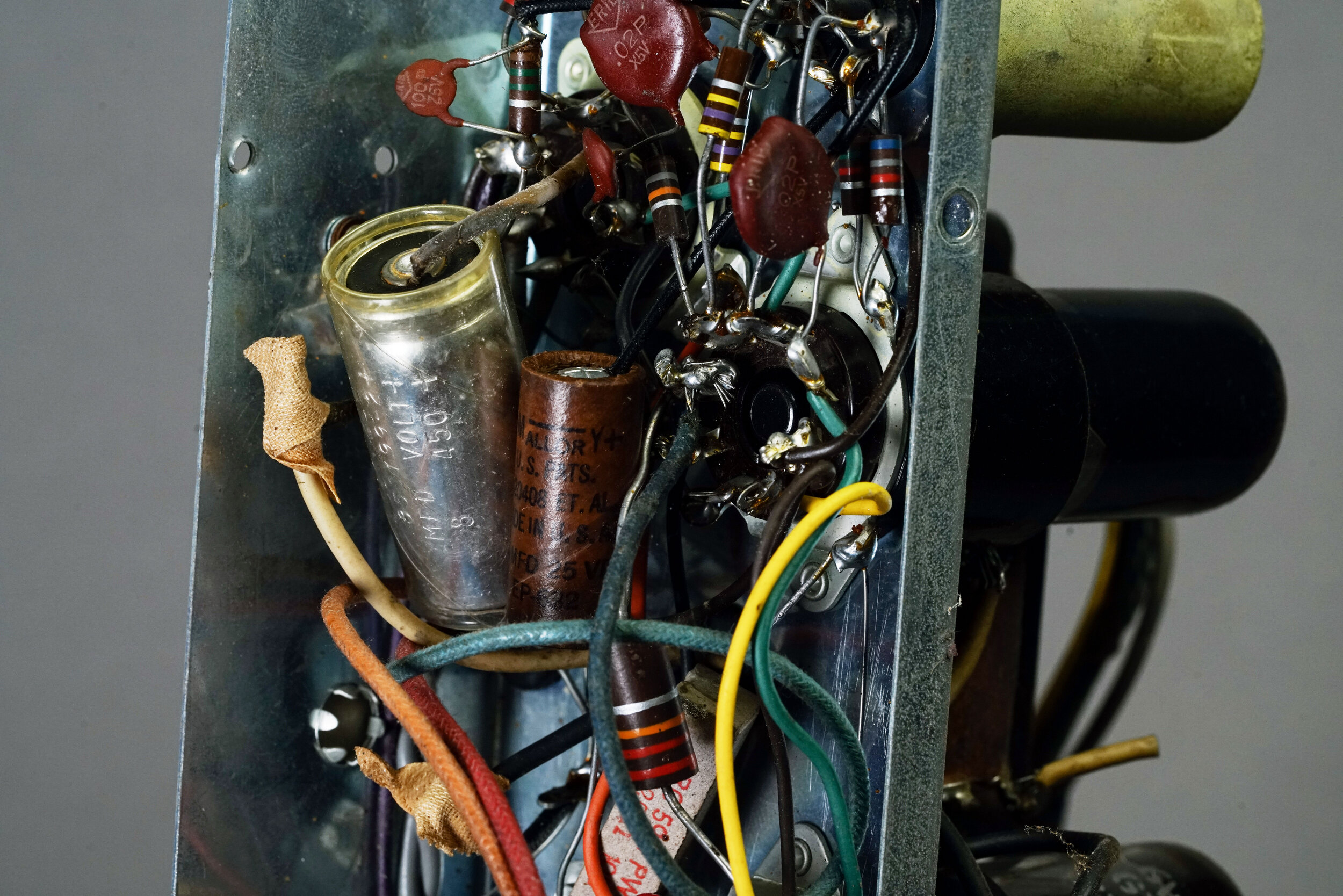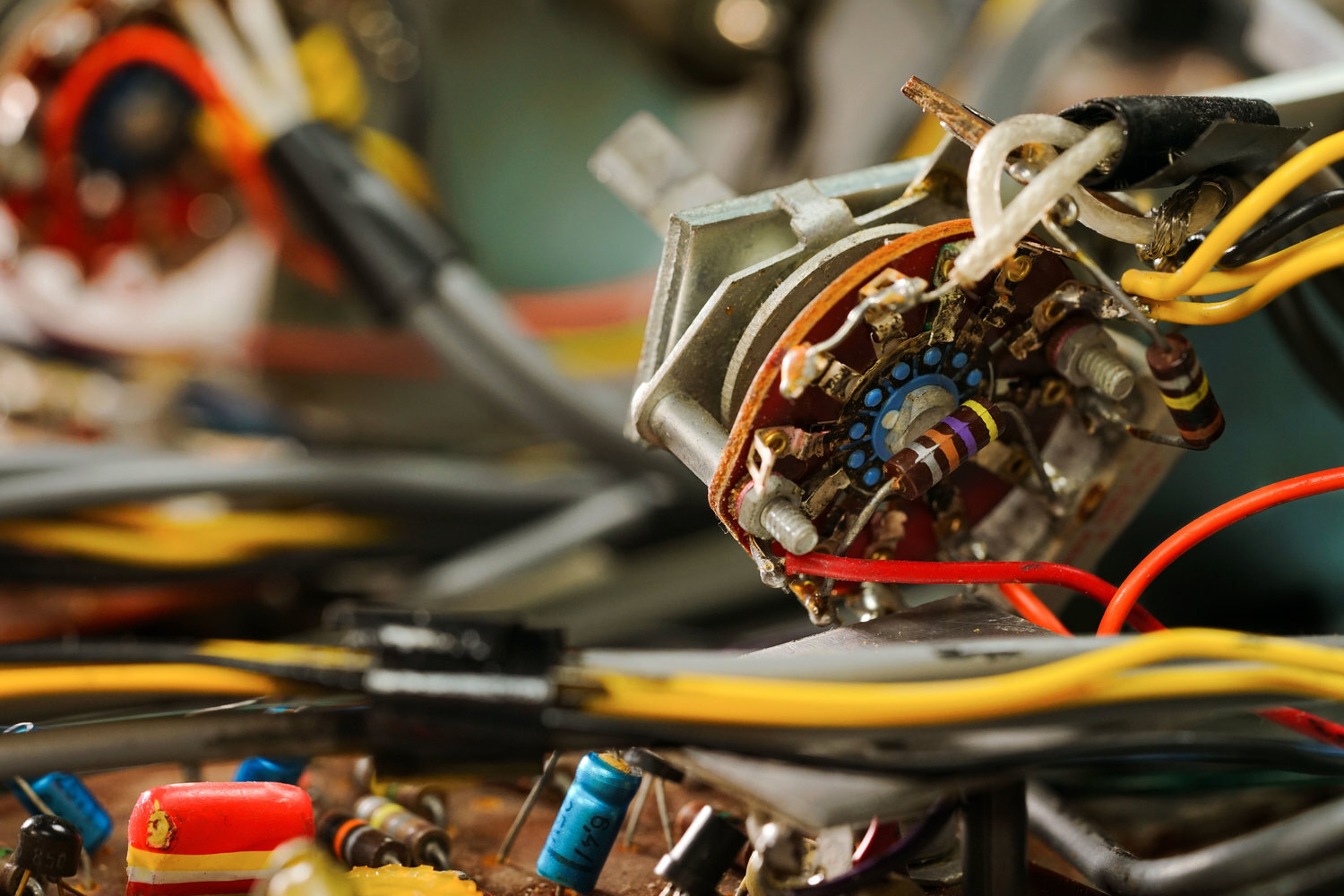On Cathode Bypass Capacitors
In this Wurlitzer 700 amplifier, the cathode bypass capacitor is the large brown Mallory in the center of the photo.
Cathode bypass capacitors are not absolutely necessary in a circuit. However, their presence or absence in an amplifier affects three things:
Gain
Frequency response
Hum
If you feel that your amp is lacking in any of these aspects, determining whether the cathodes are bypassed is a good place to start.
Cathode bypass capacitors are very common in amplifier circuits, but some older amps don't have them. If your amp is lacking cathode bypass caps, and you're happy with its sound, you don't need to add one. However, if you feel that your amp could use a small gain boost, or if your amp is noisy, you may want to add cathode bypass caps to the circuit. This guide will explain why and how.
Note that adding capacitors to an amp involves modifying a high-voltage circuit, so you should only attempt this if you have some experience working on tube amps. Otherwise, an amp tech can do it for you. Learn about our amplifier mail-in repair service here.
Spot the cathode bypass capacitors! (One is in the capacitor can in the top left corner.)
How does the cathode bypass capacitor affect gain, frequency response, and hum? Any gain stage in a standard amplifier requires a cathode resistor. (Typical values are around 1.5k ohms but could be much higher or lower depending on the purpose of the gain stage.) The voltage drop across this resistor provides the bias point for the gain stage. With just a single resistor in this position, the gain stage will amplify and the amp works just fine. You will often find this setup in simple amplifiers such as early 5F1 Champs.
However, the presence of a cathode resistor creates a local negative feedback loop. This is called cathode degeneration, and despite the negative connotation of its name, it could be desirable (or not) based on the designer’s goals for the gain stage. Negative feedback decreases gain and promotes linearity. In this case, it also increases the stage’s output impedance. If the circuit benefits from these features, the designer may omit a bypass capacitor from one or more gain stages.
Cathode bypass capacitors also increase the cost and complexity of an amplifier - in minute ways, granted, but, depending on the penny-pinchingness of the manufacturer, maybe enough to make a difference in the cost-benefit analysis. So, the absence of a bypass capacitor in a vintage amplifier may be a tonal decision, or an economic decision. You can guess which by evaluating the overall purpose of the amplifier and its build quality.
In general, a fully-bypassed gain stage is louder and richer than one lacking a bypass capacitor. This often affects the amplifier’s distortion tone and capacity for overdrive. Gain stages without cathode bypass capacitors tend to have a milder tone and a more linear frequency response.
Enjoying this article? Subscribe to our newsletter for weekly repair tips & other vintage amplifier & electronic repair content!
Cathode bypass capacitors are often implemented in a circuit to affect three things: gain, frequency response, and noise.
Gain. Negative feedback reduces gain. Because the cathode bypass cap eliminates the negative feedback loop, the amp will have more gain with the cap than without it. Some people prefer the comparatively mellow sound of an unbypassed gain stage. Others like the extra drive that a bypassed gain stage offers.
Frequency response. The capacitance of the bypass cap determines which frequencies are boosted. If a smaller capacitor is used, only higher frequencies will be bypassed. This is, of course, a way to attenuate the low end of an amplifier and give the tone a little extra sparkle.
A gain stage is considered “fully bypassed” if the bypass cap covers all practical frequencies. Generally, 25 uf is sufficient. To boost only high frequencies, use a capacitor around 1 uf. Add more capacitance to start covering the mids as well: 4.7 uf and 10 uf are also common values.
Noise. Cathode bypass capacitors can also reduce the noise floor of an amplifier. To understand how, you’ll need a little background on how a tube works. Inside a tube, there is a piece of metal called the cathode. If the cathode is hot, it will release electrons into the tube’s vacuum. This flow of electrons can then be used to amplify a signal voltage.
The cathode is heated by the filament (aka the heater), which in most amplifiers is powered by a 6.3v AC winding on the power transformer. The filament must be physically close to the cathode in order to heat it up. (In the earliest tubes, the filament and the cathode were actually one and the same.) However, if the filament is too close, its AC voltage will leak into the cathode - and therefore the signal path. This results in audible hum.
In this Wurlitzer 700 circuit, the cathode bypass cap is the yellowish electrolytic at the top left. Today, electrolytic capacitors are much smaller than this.
Tubes prevent heater-cathode leakage by insulating the two electrodes from one another. Unfortunately, whether your tube has really good heater-cathode insulation is pretty much up to random chance at this point. (Surprise: most current-production tubes do not have bulletproof heater-cathode insulation.)
If the heater-cathode insulation isn’t accomplished inside the tube, it needs to be done electronically, inside the circuit. Here you have two options: clean up the heater, or beef up the cathode. Rectifying and filtering the heater circuit is an elaborate task, and it is pretty much impossible to retrofit an existing vintage amp with DC heaters.
On the other hand, decoupling the cathode is pretty simple: all you need is - yes! - a relatively large cathode bypass cap. Usually, 25 uf is sufficient, although you could experiment with somewhat higher values. If your goal is noise reduction, the best place to add a cathode bypass cap is at the input gain stage, because noise introduced here will be amplified by all subsequent circuitry in the amp.
Early- and late-preamp cathode bypass capacitors. In general, earlier gain stages have the biggest effect on the amplifier’s tone. For the most gain boost, widest frequency response, and maximum noise reduction, place the largest cathode bypass capacitors in the earliest gain stages.
Traditionally, you will usually see smaller-value bypass caps later in the preamp. Common values include 25 uf for input stages, and 10 uf for late-preamp gain stages. Adjusting these values will give you subtle tonal changes. But if you reduce the value of a bypass cap and experience increased hum, the heater-cathode insulation is likely to blame.
How can I tell if I have cathode bypass capacitors in my amplifier? Cathode bypass capacitors will be connected to the cathode pin, either directly or via a wire, in parallel with the cathode resistor. On a preamp tube in the 12AX7 family, the cathodes are on pin 3 and pin 8.
Due to their relatively high capacitance, cathode bypass capacitors are traditionally electrolytics. If a partially bypassed cathode calls for a very small capacitance value, other styles of capacitors, such as polyester or polypropylene, might be used. However, in a vintage tube amp, you are almost guaranteed to see electrolytics as cathode bypass capacitors.
Earlier Wurlitzer 120 and 700 amplifiers are often lacking cathode bypass capacitors. In these amps, the cathode is shared by both halves of the single preamp tube, so only one capacitor is required. Service manuals of the period advise adding a cathode bypass capacitor if the amplifier has excessive hum.
Further Reading
Browse all of our articles on restoring vintage gear. Or, click on an image below.







